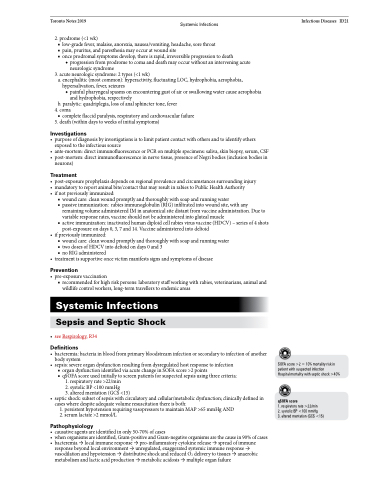Page 621 - TNFlipTest
P. 621
Toronto Notes 2019 Systemic Infections
2. prodrome (<1 wk)
■ low-grade fever, malaise, anorexia, nausea/vomiting, headache, sore throat
■ pain, pruritus, and paresthesia may occur at wound site
■ once prodromal symptoms develop, there is rapid, irreversible progression to death
◆ progression from prodrome to coma and death may occur without an intervening acute neurologic syndrome
3. acute neurologic syndrome: 2 types (<1 wk)
a. encephalitic (most common): hyperactivity, fluctuating LOC, hydrophobia, aerophobia,
hypersalivation, fever, seizures
◆ painful pharyngeal spasms on encountering gust of air or swallowing water cause aerophobia
and hydrophobia, respectively
b. paralytic: quadriplegia, loss of anal sphincter tone, fever
4. coma
■ complete flaccid paralysis, respiratory and cardiovascular failure
5. death (within days to weeks of initial symptoms)
Investigations
• purposeofdiagnosisbyinvestigationsistolimitpatientcontactwithothersandtoidentifyothers exposed to the infectious source
• ante-mortem:directimmunofluorescenceorPCRonmultiplespecimens:saliva,skinbiopsy,serum,CSF
• post-mortem:directimmunofluorescenceinnervetissue,presenceofNegribodies(inclusionbodiesin
neurons)
Treatment
• post-exposureprophylaxisdependsonregionalprevalenceandcircumstancessurroundinginjury • mandatorytoreportanimalbite/contactthatmayresultinrabiestoPublicHealthAuthority
• ifnotpreviouslyimmunized:
■ wound care: clean wound promptly and thoroughly with soap and running water
■ passive immunization: rabies immunoglobulin (RIG) infiltrated into wound site, with any
remaining volume administered IM in anatomical site distant from vaccine administration. Due to
variable response rates, vaccine should not be administered into gluteal muscle
■ active immunization: inactivated human diploid cell rabies virus vaccine (HDCV) – series of 4 shots
post-exposure on days 0, 3, 7 and 14. Vaccine administered into deltoid • ifpreviouslyimmunized:
■ wound care: clean wound promptly and thoroughly with soap and running water ■ two doses of HDCV into deltoid on days 0 and 3
■ noRIGadministered
• treatmentissupportiveoncevictimmanifestssignsandsymptomsofdisease
Prevention
• pre-exposurevaccination
■ recommended for high risk persons: laboratory staff working with rabies, veterinarians, animal and
wildlife control workers, long-term travellers to endemic areas
Systemic Infections
Sepsis and Septic Shock
• seeRespirology,R34
Definitions
• bacteremia:bacteriainbloodfromprimarybloodstreaminfectionorsecondarytoinfectionofanother body system
• sepsis:severeorgandysfunctionresultingfromdysregulatedhostresponsetoinfection
■ organ dysfunction identified via acute change in SOFA score >2 points
■ qSOFA score used initially to screen patients for suspected sepsis using three criteria:
1. respiratory rate >22/min
2. systolic BP <100 mmHg
3. altered mentation (GCS <15)
• septicshock:subsetofsepsiswithcirculatoryandcellular/metabolicdysfunction;clinicallydefinedin cases where despite adequate volume resuscitation there is both:
1. persistent hypotension requiring vasopressors to maintain MAP >65 mmHg AND 2. serum lactate >2 mmol/L
Pathophysiology
• causativeagentsareidentifiedinonly50-70%ofcases
• whenorganismsareidentified,Gram-positiveandGram-negativeorganismsarethecausein90%ofcases • bacteremia→localimmuneresponse→pro-inflammatorycytokinerelease→spreadofimmune
response beyond local environment → unregulated, exaggerated systemic immune response → vasodilation and hypotension → distributive shock and reduced O2 delivery to tissues → anaerobic metabolism and lactic acid production → metabolic acidosis → multiple organ failure
Infectious Diseases ID21
SOFA score >2 = 10% mortality risk in patient with suspected infection
Hospital mortality with septic shock >40%
qSOFA score
1. respiratory rate >22/min
2. systolic BP <100 mmHg
3. altered mentation (GCS <15)


